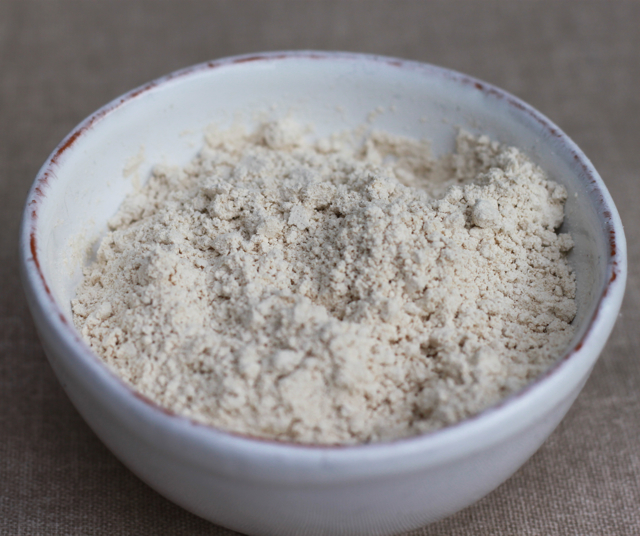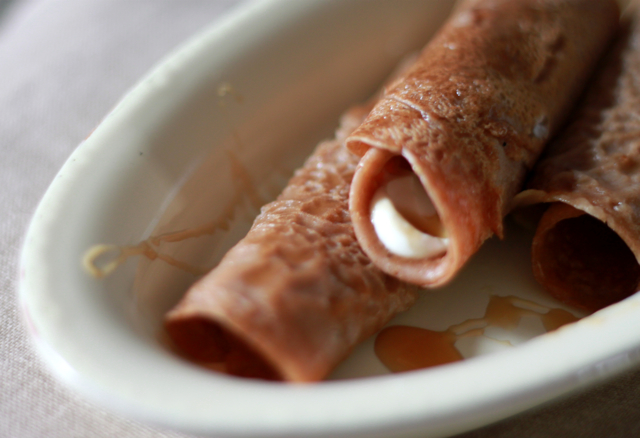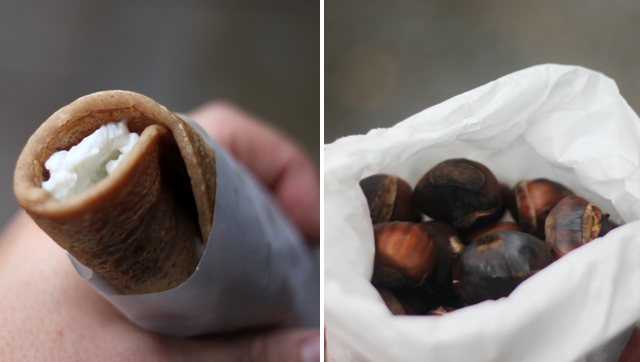Chestnut flour is a great reminder of autumn that easily stretches out my favourite season to last throughout winter. Readily available throughout Tuscany, chestnut flour is produced locally all over the region from Prato to Amiata to be made into pasta, bread and pastries. It is also the essential ingredient in one of my favourite cold weather snacks, Necci.

Chestnut flour has a naturally low moisture content, which means in centuries past it was traditionally a good flour for keeping stacked away for the winter. It is also gluten-free, which makes it perfect for celiacs.
In the past, chestnuts were a staple in the Apennine and Alpine regions of Italy, and many peasant dishes included chestnuts in some way, as a stuffing for meat or a quiche-type filling, while chestnut flour was used to make a polenta or porridge-like dish. They say that after the war, polenta saved the north of Italy, fish saved the south and chestnuts saved central Italy. There are recipes dating back to the 16th century that describe cooking chestnuts over coals and eating them seasoned with salt and pepper, or soaked in wine or grappa. Often, Renaissance chestnuts were served piping hot on a bed of rose petals to infuse them with the beautiful perfume of the flowers.
Castagnaccio is probably one of the best of the ancient chestnut recipes that it still lovingly made every season all over Tuscany – a sort of flatbread made with chestnut flour, raisins, pine nuts and rosemary.
My absolute favourite chestnut recipe, however, is the humble Necci. It’s a sort of chestnut flour crepe, eaten plain or warm with a dollop of fresh sheep’s milk ricotta cheese, typical of the Tuscan region of the Garfagnana, a mountainous area near Lucca covered in plenty of chestnut forest.

There is something very medieval about making Necci. To start with, you need a good fireplace with a roaring fire and glowing coals and a pair of cast-iron testi – two flat, heavy iron plates, about 25 cm in diameter, with long flat handles. Nothing says “Medieval” like cast-iron.
What’s unusual about this crepe-like delicacy is that rather than spread the batter and flip it, the batter is spooned onto the lightly greased testo (if you have a piece of lardo handy, this is what’s usually used, otherwise a bit of olive oil is fine), and is spread and flattened by placing the other testo on top. With both hands, the testi simply get flipped over the fire together until both sides are cooked evenly (this is great for people not confident in their flipping skills). The necci are then piled between chestnut leaves until the batch is ready to eat.
The simple batter – water and flour – is slightly sweet, thanks to the natural flavour of the chestnut, and is traditionally eaten alone or with some ricotta, but it also lends itself well to savory fillings of prosciutto, or sweet fillings such as nutella. My favourite is a bit of ricotta and a drizzle of chestnut honey.
Where I go to get my Necci fix in Florence is the Santo Spirito market, the 2nd Sunday of the month. The elderly couple that still prepare Necci the traditional way and cook them on the spot with testi seem like a postcard from another era. And for 2.50 euro each with fresh ricotta, it’s a snack I never pass up when I see it. In the right season you may also find someone roasting chestnuts.


The recipe couldn’t be simpler but it’s the flipping that’s tricky if you don’t have a pair of testi handy. While the traditional recipe calls only for chestnut flour and some tap water to make a slightly thick batter (thicker than crepe batter), I find that if you’re going to make it on a regular pan and attempt to flip it over, you’ll need to add a little olive oil to the mixture to stop it from simply falling apart as soon as you touch it. Greasing in between each neccio really helps too.
Necci with ricotta and honey
- 250 grams of chestnut flour
- 1 cup of water
- 1 tablespoon of olive oil
- pinch of salt
- lard, butter or olive oil for greasing
- sheep’s milk ricotta
- chestnut honey
In a large bowl, mix the flour with enough water to get a smooth, dense batter, slightly thicker than crepe batter. Add olive oil and a pinch of salt and mix again. Heat and lightly oil a frying pan. Add a couple of spoonfuls of the batter to the pan and tilt slightly to evenly coat the pan (note that this batter does not move as fluidly as crepe batter).
Cook for about 2 minutes or until you see that the top of the batter looks dry. Loosen with a spatula, flip over and cook the other side for one minute. Set aside and keep warm. When all the necci are ready, spread some fresh ricotta on each, roll them up and serve drizzled with honey.




Comments
It was chestnut flour which led me to Artusi’s cookbook – I ended up making cakes with it but these pancakes look delicious – the sweetness balanced with the creaminess of the ricotta
Thanks for your comments, Kitchen Butterfly. Chestnut flour has such a unique flavour and texture; it makes great pasta too! Necci are my favourite use for chestnut flour, though, hope you get a chance to try them out!
we met the elderly couple in Florence making necci in a farmers market. It tasted wonderful
and we plan to make necci regularly
Aren’t they wonderful? I can never seem to make them as well as the elderly couple do, I think experience plus the cast iron “testi” really help!
we landed making the first batch like crepes. the ones the elderly couple made were thicker; their batter was thicker. where do we find testi ?
a few raisins in the dollop of fresh ricotta tastes good!
there is a north indian desert called Halva (pronounced hulva). In kashmir (india), halva is sometimes made from chestnut flour. The smell was familiar to me and i am happy to say that my nose led me to this elderly couple and the wonderful necci !
You’re right, the batter needs to be quite thick (thicker and denser than crepe batter) for these to work out right. Testi are probably pretty hard to find outside of Italy (even locally they’re not that simple to get anymore!) but you can do it with a regular crepe pan and a lot of patience! Raisins sound like a great idea, I like the idea of pinenuts in there too!
Do you think this will work if I blend cooked/vacuum packed chestnuts with enough water to make the batter?
I don’t think so – chestnut flour is dried out completely before being turned into flour so the proportions and quantities of liquid to dry ingredients would be quite different. I’m sure you could do an internet search for a supplier of chestnut flour, though, it’s quite common to find now in specialist shops, delis or health food shops.
Perfect!
Thank you for explaining what a testi is.
I can use my Krumkake maker.
Now all I have to do is find the chestnut flour.
Have a Joyful Day :~D
Charlie
Lovely recipe – about how many crepes does a single batch make?
This makes about 8 small crepes (give or take — you might lose the first one, happens all the time!)
I know you moved but any idea if this stand still exists and if it’s still the same day of the month? Clearly this blog post stuck in my mind for over a decade and now that I’m planning a trip to Florence in February I would love to make this stand part of it. Thanks!
Hi, yes it’s still there but the little old couple are no longer running it, but you should still find the necci stand at the organic market “Fierucola” in Piazza Santo Spirito on the 3rd Sunday of the month. Also keep an eye out on @necciaio on instagram, he makes great necci and does pop ups – recently at Eataly in Florence.